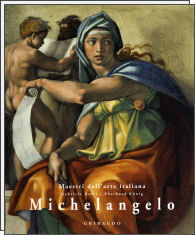EDIZIONE
ITALIANA  |
SOMMARIO
L'arte fra il divino e il terribile
Gli inizi a Firenze e Roma
David e la scelta di una figura simbolo per la città
Il non finito
Michelangelo e papa Giulio II
Roma e l'antichità classica
A Firenze sotto i papi della famiglia Medici Leone X e Clemente VII
Di nuovo a Roma sotto papa Paolo III Farnese
Il "Giudizio Universale" e il Concilio di Trento
La cappella Paolina e la costruzione della basilica di S. Pietro
Le ultime opere della Passione
Cronologia
Glossario
Bibliografia scelta/Crediti fotografici
L'ARTE FRA IL DIVINO E IL TERRIBILE
Nessuno ha cambiato l'immagine dell'artista in modo così radicale, nessuno l'ha impressa nei posteri in maniera così decisa come Michelangelo Buonarroti, artista dalla personalità complessa cui già i suoi contemporanei attribuivano caratteristiche come la "divinità" o la "terribilità". In un mondo che basava tutta la sua esperienza sul glorioso e perduto passato degli antichi, Michelangelo segnò un nuovo inizio. Ancor più che Raffaello o Leonardo egli incarnò un ideale artistico caratterizzato da una immagine radicalmente nuova dell'uomo e delle sue possibilità, un ideale che non aveva più niente a che fare con le tradizioni artigiane.
Il grande pittore di Firenze, destinato a diventare uno dei più insigni scultori e architetti di tutti i tempi, non ebbe un tale impatto sui suoi contemporanei e sulle generazioni a venire grazie alla "piacevolezza" del suo carattere e delle sue opere; al contrario, la sua presenza e i suoi lavori divisero gli animi, suscitarono scherno e si scontrarono con un netto rifiuto. [..] |
EDIZIONE
INGLESE  |
CONTENTS
Art between the Divine and the Terrible
The Beginnings in Florence and Rome
Inset: David and the Choice of Patron for the City
Inset: The Appreciation of the Unfinished
Michelangelo and Pope Julius II
Inset: Rome and Antiquity
In Florence under the Medici Popes Leo X and Clement VII
Back in Rome under the Farnese Pope Paul III
Inset: Michelangelo's Last Judgement and the Council of Trent
The Cappella Paolina and the Construction of St. Peter's
Last Works of the Passion
Chronology
Glossary
Selected Bibliography
Photographic Credits
ART BETWEEN THE DIVINE AND THE TERRIBLE
No one changed the image of the artist so thoroughly and recast it for posterity so decisively as did Michelangelo Buonarroti. Even his contemporaries referred to him as the divine or terrible, accorded him divinità or terribilità. In a world in which all experience was based in the glorious lost past of Antiquity, he made a new beginning. Michelangelo, more even than Raphael or Leonardo, embodies a standard of artistic genius which reveals a radically changed image of human beings and their potential and no longer has anything to do with crafr traditions.
It was not because his character or his works were agreeable that the great painter from Florence, who became one of the most important sculptors and architects of all time, had such an effect on his surroundings and future generations. On the contrary, Michelangelo's personal manner as well as his works divided opinions, aroused ridicule and outright rejection. [..]
EDIZIONE
TEDESCA  |
INHALT
Kunst zwischen dem Góttlichen und dem Schrecklichen
Die Anange in Florenz und Rom
Exkurs: David und die Wahl eines Stadtpatrons
Exkurs: Die Wertschkzung des Unvollendeten
Michelangelo und Papst Julius II.
Exkurs: Rom und die Antike
In Florenz unter den Medici-Npsten Leo X. und Clemens VII.
Zuriick in Rom unter Papst Paul III. aus dem Hause Farnese
Exkurs: Michelangelos Jiingstes Gericht und das Konzil von Trient
Die Cappella Paolina und der Bau von St. Peter
Letzte Werke der Passion
Zeittafel
Glossar
Auswahlbibliographie, Bildnachweis
KUNST ZWISCHEN DEM GÓTTLICHEN UND DEM SCHRECKLICHEN
Keiner hat das Bild des Kiinstlers so stark verandert und so entschieden fiir die Nachwelt gepragt wie Michelangelo Buonarroti. Schon seine Zeitgenossen nannten ihn den Giittlichen oder den Schreckenerregenden, sprachen ihm »divinità« oder »terribilità« zu. In einer Welt, die alle Erfahrung auf die glorreiche verlorene Vergangenheit der Antike griindete, setzte er einen Neubeginn. Starker noch als Raffael oder Leonardo verkhrperte Michelangelo den Mallstab fair ein Ktinstlertum, das eM radikal gewandeltes Bild vom Menschen und seinen Móglichkeiten versar und mit Handwerkstraditionen nichts mehr zu tun hat.
Der groge Maler aus Florenz, der zu einem der bedeutendsten Bildhauer und Architekten aller Zeiten wurde, wirkte auf seme Umgebung und auf kommende Generationen nicht etwa, weil sein Wesen oder seme Werke gefallig gewesen waren. [..] |
 
 
 

Gabriele Bartz - Peter Hohenstatt
MAESTRI DELL'ARTE ITALIANA - MICHELANGELO
editore GRIBAUDO
edizione 2007
pagine 120
formato 22x25,5
plastificato a colori
tempo medio evasione ordine
5 giorni
9.90 €
4.90 €
ISBN : 978-3-8331-3823-2
EAN : 9783833138232
|
|